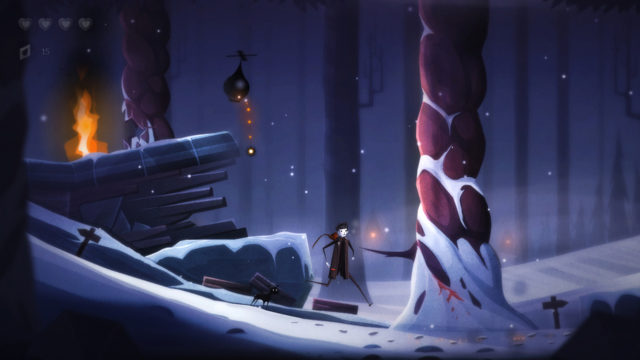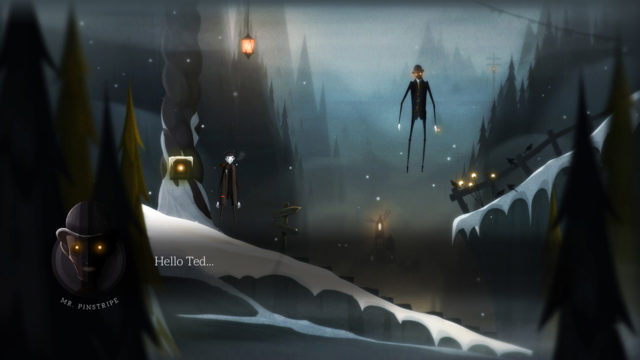Fantastic art and soundtrack; great, emotionally affecting story; memorable characters; some well-designed and rewarding puzzles.
Combat and some puzzle concepts are underdeveloped; a few tonal shifts don't work with the overall story; short length might turn off some.
Just a few moments into Pinstripe and it becomes abundantly clear that you are playing a piece of art; a game that not only has vision, but has the vision of a single person. Aside from some voice acting, the game is entirely the product of one developer, Thomas Brush. From every line of code controlling the gameplay, to every note in the soundtrack and pixel of artwork, the responsibility rests on his shoulders. Bearing such weight is undoubtedly a herculean task, so some slip-ups are expected and Pinstripe is no exception, but there is plenty more done exceptionally well.
While Pinstripe is best defined as a 2D puzzle-platformer with the occasional sprinkling of combat, its story and atmosphere are obviously its main focus. You take control of Ted, a minister who is riding on a train with his daughter, Bo, when they are confronted by the mysterious Pinstripe, an abnormally tall and lanky man with an interest in the young girl. Before long, the titular villain abducts Bo and sends the train crashing off its rails. From there, Ted must journey through a strange world that seems to be held in Pinstripe’s thrall as he is the sole provider of Sack Juice, an apparently addictive beverage that all but a few residents obsess over. The quest across this world is purposefully odd and actually surprisingly whimsical and attentive gamers will undoubtedly start to pick up on what’s going on, because there’s more to this world and its characters than what is simply shown. Even though I saw the twist coming, the build-up and pay off were still generally satisfying.
Unfortunately, I have to use the word “generally” because sometimes the tone seems at odds with itself. Early on there is plenty of evidence for later quirkiness, but the general atmosphere is rather dark and somber in a manner reminiscent of early Tim Burton films. However, sometimes the efforts to be weird or humorous step a little too far away from the rest of the game. Every so often you encounter moments, characters, or just lines that feel a little too crude or even juvenile. They never feel completely out of place because of how unapologetically weird the game is, but they are still rather distracting and at least a little out of place. Thankfully, all of the game’s big moments, especially the ending, feel more consistent.

In terms of gameplay, Pinstripe is once again rather odd. The main focus is on puzzle solving and platforming, but the varied nature of the puzzles and the bits of combat introduce an interesting, if not occasionally underdeveloped, level of variety. The platforming generally feels good, but there are a few moments where it is exposed as a little imprecise, however the punishment for failure is always incredibly small, so you won’t often feel aggravated by those occasional missed jumps that look like they probably should have landed. The puzzles are generally better executed, however there are a surprisingly large number of puzzle types, which is both good and bad. On the one hand, jumping from switch puzzles, to environmental puzzles, to even locating differences between two similar images can be refreshing; it might have been more interesting to see a smaller number of ideas receive more development over the course of the game. As it is, the puzzles are generally satisfying and only really suffer from occasional moments of obtuseness or times where you are strictly forced to acquire certain items or hit switches in an otherwise arbitrary order.
The biggest problem is definitely the combat, though, which feels incredibly underdeveloped. Early on, you acquire Bo’s slingshot which is primarily used in puzzle solving but also serves a purpose in many of the game’s uninspired fights. Most of the time, your foes are bomb dropping balloons that are easily popped with a few shots, but they appear so infrequently and are generally so inconsequential, that they might as well not be there aside from a couple times where they serve a puzzle purpose. There is another foe that must be defeated by jumping on it multiple times (this is a platformer after all) but it only shows up twice. The inevitable showdown with Pinstripe feels perfectly fine, but also rather uninspired considering how creative so much of the rest of the game is. Ultimately, despite generally working perfectly fine, one can’t help but wonder if the game would have been better with the combat completely removed.
Most of Pinstripe‘s problems stem from an apparent effort to add more variety to the game, which I actually find unnecessary considering how short it is. Mind you we are talking about the good kind of short. Your first playthrough will likely only last between two and three hours and that’s including a few portions of tacked on backtracking and some annoyingly long load times. When the focus of a game is clearly placed on story and atmosphere, there is less need for unnecessary variety and length. Also, the game encourages multiple playthroughs with a number of unlockables, access to an overpowered weapon that makes combat even less meaningless, and a bunch of details in the world and dialogue that are given new meaning when you know the whole story.

As stated earlier, Pinstripe establishes an incredibly strong atmosphere, and that is largely accomplished through its fantastic audio and visual presentation. To put it bluntly, the game is gorgeous, with a hand drawn art style that gives each environment an otherworldly sense of place and each character a great deal of personality. Everything is presented in a very cartoony way, but there’s also a sense of everything growing progressively darker and grimier that perfectly fits Ted’s descent toward Pinstripe’s lair. The music works in very much the same way, with the various tracks capturing the feelings of somberness, weirdness, and plain evil that permeate the respective locations, events, and characters they accompany. The music from the first area of the game is especially beautiful.
While there seem to be quite a few complaints laced throughout this review, please note that these are more minor frustrations than serious complaints. All told, my general feeling is that Thomas Brush should have been more confident in the core gameplay concepts, art, story, and music he developed. These central elements are so strong and the game is short enough that extra variety is actually not that necessary. In big, epic games it’s important to give your player plenty of different things to do over the course of dozens of hours, but those requirements change with a game as clear and concise as Pinstripe. These issues might be enough to discourage some gamers, but for most it will probably serve as a fantastic way to spend a long evening or a weekend where you’re in the mood for something a little more emotionally driven than your average game, because when you reach the ending, the final moments will likely melt away every annoyance from the last few hours.
Nintendojo was provided a copy of this game for review by a third party, though that does not affect our recommendation. For every review, Nintendojo uses a standard criteria.




 ShareThis
ShareThis





